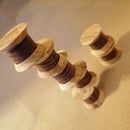Introduction: Wooden Carved Skull
I have a good old friend who wanted a wooden skull making.
Being that wood is awesome and skulls are awesome I thought it would be silly not to.
https://youtu.be/YMZLLE1Zevk
Step 1: Sketch Out Some Reference to Work From
It always makes it easier working to a sketch.
Often I will adapt from my initial sketches when I'm working in the round but doing a little thinking before hand does help.
For this little skull I found a 3D model of a skull which I could rotate to see different angles. I used the computers screen as a light box and traced some of the details in different orientations. I made sure to keep the skull at the same distance/ size.
I cannot share the file I used with the 3d skull. (Its a friends project and he hasn't published it yet.) But i can link to a grate image which can be used in much the same way. http://clz.deviantart.com/art/Different-Angles-of-a-Skull-370926521 (Hope this helps)
Step 2: Grab Your Wood and Identify Where You Want to Work
For this project I am using some maple left over from a rolling pin project. (I love it when I can use the bits left over from other projects)
This wood had a knot in it which I didn't want to be part of the skull. I identified this defect and made sure to position my initial cuts to avoid.
Step 3: Score the Thickness
I am lucky enough to have some really beautiful tools which work perfectly and save a lot of time.
If you don't have a cutting gauge you can use a ruler and a pencil or anything that's handy. I have been known to use store cards and adapt them into tools for this type of work in emergency.
I measured the thickness of the skull in my reference material and transferred this to the wood.
Step 4: Trace the Skull Profile Onto the Wood
I used a few different methods to transfer images to different surfaces but the easiest and cheapest is to scribble on the reverse of the drawing you want to transfer and then re-draw on the sketch side to push the graphite onto the wood.
I oriented the skull in a position where I thought the wood grain would look great on the finished product.
Step 5: Cut to Thickness and Lengh
Its better to cut to thickness before cutting out the skull shape.
It means less ware on the tools in the long run and working on thinner stock is easier for you.
(If you don't have a band saw you can do this with hand tools but it will be more work. (If you do this with hand tools you will probably develop some pretty awesome muscles.. I know before I had power tools woodworking was better than going to the gym, It gave great results in health and furniture))
Step 6: Cut Out Your Skull Shape
I draw over the skull shape with ink for illustration purposes. If you are happy working to a pencil line you don't have to do this.
If you don't have a band saw you might want to make some reference cuts into your material and carve to the line.
I did this to illustrate using the band saw (As long as you can put evenly you shouldn't have a problem it just takes a bit longer. But also is hugely rewarding... and you know what I was saying about woodworking being better than going to a gym... This is one of the exercises which makes you look like a bad-ass)
Step 7: Find Your Center
Its a lot easier to work out where things should be when you know where the middle is.
(DO NOT USE A CUTTING OR SCRATCH GAUGE HERE)
Don't use a cutting or scratch gauge here. You're getting closer to the finished work and it would be a shame to cut a line in it now.
I measured and made a few marks before connecting the dots and then drew on where I thought the eyes, nose and other details made sense.
Step 8: Work Out the Best Way to Hold Your Skull and Then Get to Carving
I am using a metalworking vice here, which isn't ideal, but I am also using shins on the vice to ensure the work is being held evenly around a curve and didn't crush the fibers as could be the case with a mettle working vice.
There are a few ways to carve. My preferred method is to make a cut down from one direction and then cut from a different direction to meet the first cut.
I also love to use power tools and find they shift a whole bunch of material fast . (Though it takes a little while to get used to a new tool. I would recommend reading the safety instructions and wearing goggles/ a mask and being sober. (Seriously don't do this if you are taking medication or have been drinking. It's silly (I know a person who did themselves a mischief when they were not paying attention))
Step 9: Check the Work Using Reference Tweak and Sand
Once you're happy with your carving you might want to make a few final cuts and tweaks. I thought my skull would look better sanded and I don't think he needs any finish. I think he will develop an interesting patina though being handled.




